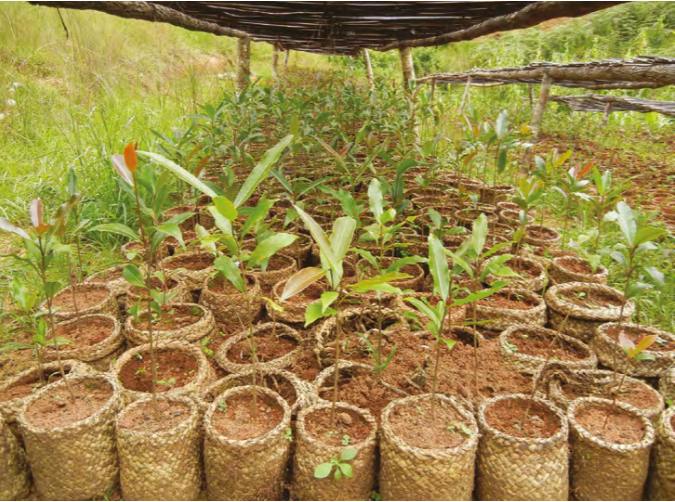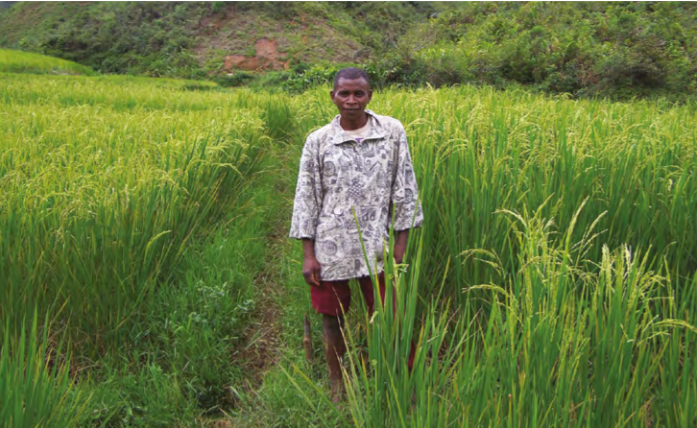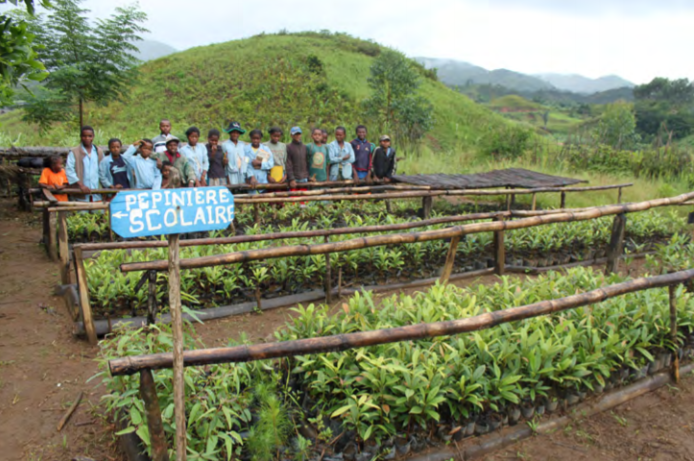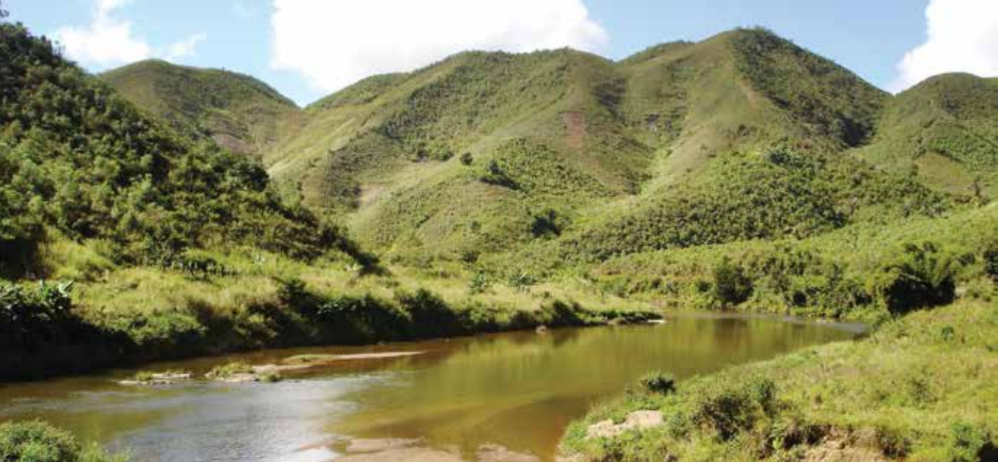Overview
In 2005, WWF began a Forest Landscape Restoration (FLR) project Madagascar’s Fandriana-Marolambo region. Forest landscape restoration aims to restore forest functions in deforested and degraded landscapes through explicitly recognizing the human and ecological benefits of restoration. Fandriana-Marolambo is home to 150,000 people from three ethnic groups, situated in a moist tropical forest ecosystem consisting of fragmented forests interspersed with savannah, exotic plantations, and fields. 90% of Madagascar’s endemic species live in forests like Fandriana-Marolambo, including eight lemur species, but they are threatened by deforestation and degradation stemming from poverty.
Community engagement was critical to the success of this FLR program program. In 2013, 95,063 ha were used to create Marolambo National Park. Another 51,743 ha were managed by community-based organisations and an area of 6,786 ha was placed either under active or passive restoration. WWF began withdrawing in 2015. Local associations fully took over in January 2018. As one of the longest standing FLR projects ever undertaken, lessons learned from this 13 year initiative are valuable both in Madagascar, as the country seeks to attain its commitment to restore 4 million ha of forest, and in other countries. Lessons learned from this FLR initiative are valuable and should be shared widely.
Quick Facts
Geographic Region:
Africa
Country or Territory:
Madagascar
Biome:
Tropical Forest
Ecosystem:
Tropical Forest - Moist Broadleaf
Area being restored:
200,000 hectares
Project Lead:
World Wildlife Fund (WWF)
Organization Type:
NGO / Nonprofit Organization
Project Partners:
Madagascar National Forest Service
NGOs in Madagascar such as Loharano and Fanilo Spam
Four unions/networks of COBAs (Mitafa, Soamirindra, Vahivahy and Tambazotra)
Project Stage:
Planning / Design
Start Date:
2004
End Date:
2015
Primary Causes of Degradation
Agriculture & Livestock, Deforestation, Fire & Weather Events, Mining & Resource ExtractionDegradation Description
Madagascar has been losing its forests consistently in the last 20 years. Between 1990 and 2010, about 57,000 ha of forest was lost each year, netting a total loss of over 1 million ha in this 20-year period. Before the project, deforestation rates were severe, reaching 2.58% in Fandriana, 1.38% in Mahanoro and 2.86% in Antanifotsy (regions of Madagascar) for the period 1990-2000 . As elsewhere in Madagascar, the main direct cause of deforestation is slash and burn agriculture with limited periods of fallow in between which reduces the soil’s ability to regain fertility, leading to the quest for more land, migration and more intensive burning. With a population growing at a rate of 3%, the need for further land to feed the population is inevitable. In the east of the landscape, forests are burnt for rice and sugarcane cultivation, and a small amount of coffee, banana and clove is also cultivated in the hills. In the west of the landscape, rice paddy cultivation is the mainstay, with some migration into the forest in between seasons to cultivate sugarcane. Faced with unclear and overlapping tenure, clearing forest is also a means of “acquiring” land. As a result, the forest in Fandriana-Marolambo is severely fragmented. Instability and poverty have been major underlying indirect causes of environmental degradation. Uncontrolled fires, collection of wood and non-timber forest products, and illegal commercial logging has led to an estimated forest loss of 40,000 ha/year between 1990 and 2005. Additionally, the illegal production of sugarcane for rum turned out to be one of the main factors causing degradation to part of the forest corridor.
Defining the Reference Ecosystem
The reference ecosystem is based on diverse sources of information (e.g. multiple extant reference sites, field indicators, historical records, predictive data).Reference Ecosystem Description
The reference ecosystem was selected based on existing natural remnants of the Fandriana-Marolambo tropical forest and previous knowledge of the ecosystem structure. The area is mountainous with an elevation range from 800 to 1800m. Fandriana Marolambo is an area of exceptional biodiversity and endemism covering about 200,000 ha of cultivated fields, fallows, grasslands, savannahs, exotic forests (pine and eucalyptus) and native forests. The high biodiversity of the area is due to fragments of both degraded and relatively pristine forests which form a 80,000 ha largely intact forest corridor with a width of 5 to 20km. Floristically, the forests present a high rate of endemism with for example the endemic Melanophyllaceae family as well as numerous epiphytes.
Project Goals
- Conserve the unique biodiversity and functional integrity of the forest
- Restore forest goods and ecological service
- Improve the well-being of the people living in the area
- “The goods, services and authenticity of the moist forests of the landscape of Fandriana-Marolambo are restored so as to support the development of the populations and to secure the objectives of biodiversity conservation.”
- Raise awareness among the local population and decision-makers about climate change, addressing deforestation and promoting FLR as a mitigation measure for climate change through its role in reducing greenhouse gas emissions.
- Dispel myths about the facility of using tree planting as an easy option rather than reducing greenhouse gas emissions.
- Relieve pressure on the Marolambo National Park (established in 2013), but also on other natural forest in the landscape.
Monitoring
Stakeholders
The project team consulted extensively with local communities to elaborate a common vision of land use, identify their needs and wants, and develop opportunities for alternative livelihoods to alleviate poverty and reduce pressures on the area. Passive restoration sites were reinforced by traditional law or ‘Dina’ established by the communities, which helps make their engagement more official and protects sites against encroachment.
One important goal was to build the capacity of grassroots communities to manage their own resources through Communautés de base (COBA). This voluntary process starts with the development of appropriate structures within the COBA, followed by socioeconomic studies and forest surveys of communities’ habits and needs, which allow for the identification of thresholds for sustainable use of natural resources. Management plans are developed which indicate strictly protected zones and areas where use of natural resources is allowed. Currently, eight COBAs—approximately 900 households or 5,000 people—have volunteered for these natural resource management transfers.
How this project eliminated existing threats to the ecosystem:
Key activities implemented were the engagement of the local populations and authorities, and ensuring that the project was inserted into the development plans of all 14 landscape communes. Contracts were signed with local communities to set aside areas for passive restoration in 50 sites. Active restoration was implemented together with communities in 73 sites covering a total of 500ha.
The project used both passive and active restoration approaches, removal of invasive plants and creation of firebreaks to protect against brush fires. The project worked with local communities to develop strategies to reduce anthropocentric threats to the ecosystem. The strategies included agreeing on a joint vision for the landscape; clarify roaches to restore ecological integrity by promoting natural regeneration and acceleration of forest succession in some 5,000 ha through the removing land status and tenure; introducing the forest landscape restoration (FLR) concept and ensuring it was adopted within local development plans; building on local associations; supporting and initiating long term sustainability. Other activities attempted included adapting agriculture practices to be more sustainable, identifying alternative income-generating options for local farmers, restoration activities such as nursery development (particularly in partnership with local schools), and transferring management rights to COBAs.
How this project reinstated appropriate physical conditions (e.g. hydrology, substrate)",:
The project succeeded in restoring native tree species on degraded lands using old pre-existing exotic tree species which facilitated their growth.
How this project achieved a desirable species composition:
Invasive plants were removed from 5,000 hectares and local communities were educated about the value of native local species for restoring degraded lands.
Ecological Outcomes Achieved
Eliminate existing threats to the ecosystem:
The first result of the project is the reduction of ongoing deforestation. In the western part of the landscape the deforestation rates were very high before the project (e.g. 2.20% per year in the commune of Fandriana, 3.56% in Antanifotsy during the period 1990- 2005). During the period 2006 to 2016, this rate has been maintained below 1% per year, partly as a result of the development of sustainable agriculture (rice) by local communities.
In the eastern part of the landscape, the situation is more sensitive: the two main pressures, illegal rose wood extraction and sugar cane cultivation (for rum production) are still present (deforestation is about 1%), attributed to migrants and uncontrolled by local communities or the forest department.
Reinstate appropriate physical conditions",:
The restoration of indigenous forest improved soil fertility and quality of previously depleted soils.
Achieve a desirable species composition:
Local communities changed their negative perception of local species, which they used to think were difficult to produce and grow on degraded land and were slow growing. Now they see the value of local species and have acquired the knowledge to grow them. As a result, there is a 75% survival rate for indigenous trees. Understanding the value of forests, notably to secure water, local communities are willing to set aside fields for restoration. Different methods have been tested, including transplanting wild saplings into nurseries, transplanting saplings directly onto the sites, germination in nurseries, direct seeding and pre-germination and cuttings. Based on this experience, transplanting saplings into nurseries first was found to be the best method to scale up production, with 80% of plants being produced in this way in the landscape. Old stands of exotic species present in the landscape (e.g. Eucalyptus stands of over 30 years) have also acted as nurse trees, improving local soil conditions and facilitating the growth of native species below.
Reinstate structural diversity:
The project actively restored 500 ha of forest, setting up 58 nurseries to produce and propagate 100 or so native plant species.
Factors limiting recovery of the ecosystem:
In the eastern part of the landscape, two large deforestation culprits, illegal rose wood extraction and sugar cane cultivation, are still present because of a high movement of migrants and a lack of oversight by local communities or the forest department.
Socio-Economic & Community Outcomes Achieved
Economic vitality and local livelihoods:
Research in the third phase of the project centered on improving the quality of life of local communities and identifying financing options (e.g. microcredit schemes) to help communities expand and improve their livelihoods, as well as help them to connect to markets.
Recognizing the importance of lifting the landscape inhabitants out of poverty so that they could be in a position to better protect and restore their unique natural environment, an emphasis was given to alternative livelihood approaches. The project sought to convince local communities to adopt alternatives to traditional shifting agriculture through demonstration rather than just teaching. Good progress in terms of improved agricultural techniques and both active and passive restoration were observed.
Involvement of local communities in forest management was achieved through COBAs and management contracts. To date 40 pilot projects have been established on sites held by community associations. Funding secured from the Swedish aid agency, SIDA, (EUR 298,424) contributed to empowering local communities by strengthening the institutional capacity of community-based organisations and supporting exchanges among these organizations.
Provision of basic necessities such as food, water, timber, fiber, fuel, etc.:
Community associations were trained in alternative agricultural activities that are more sustainable for the forest system including agroforestry, beekeeping, composting, cropping systems and others. Trainees were then encouraged to implement the new techniques in their villages, which in turn become the focus of dissemination tours where the benefits of the new activity are demonstrated.
Cultural dimensions such as recreational, aesthetic and/or spiritual:
Radio shows and events were organised in the main towns together with the forestry administration and the local authorities. Fact sheets, posters and banners, as well as t-shirts and caps, and a documentary were produced. An annual walk was held across the forested corridor. Called the “Diabe”, this march was organised to raise awareness among villagers and the authorities about their important natural heritage. During the march, the emphasis was placed on halting deforestation, forest fires and illegal logging of precious trees.
Regulation of climate, floods, disease, erosion, water quality, etc.:
FLR helps to not only sequester carbon (mitigation) but it also helps both biodiversity and humans to adapt to changing conditions by, for example, protecting fields and human settlements from flash floods.
Has the project had any negative consequences for surrounding communities or given rise to new socio-economic or political challenges?:
One unexpected development was that project staff had to be significantly upscaled because of the communities’ lack of involvement in the development of the project and in their initial distrust of outside intervention. As such, the project was led by a coordinator based out of Fandriana but also counted on several local level facilitators to work with the communities, and two extension officers (“socio-organisateurs”) one for each of the western and eastern ends of the landscape.
Key Lessons Learned
The Fandriana Marolambo project has made significant progress in a short time given the many challenges it has faced. Over the years, the project had to evolve, build on previous phases and adapt responsively to local needs. These have included difficulties in hiring staff and consultants with the required expertise to address illegal production of sugarcane for rum, one of the main factors causing degradation to part of the forest corridor and not identified early on as a problem. Managing expectations has been particularly difficult. WWF was the only outside organization working in some communities, and there was pressure to accommodate community requests not directly related to project objectives such as reproductive health advice and transportation needs.
- Given the extensive poverty within the project area, the restoration project required a comprehensive approach that has led to widespread support by communities and more lasting results. This integrated and innovative approach, however, made the project much more complex to implement and harder to sell to potential lenders and funders.
- Forest restoration at a landscape level needs to be a long-term initiative. Five years is not sufficient, both from an ecological perspective and one of changing social and economic practices. Yet funders generally provide funding on a 1- to 5-year time horizon and long-term financing is a challenge.
- The state is weak. Providing ongoing support for local coordinators as part of the project team has meant the project could progress even during political crisis at the national level.
- Overall the high investment in local engagement has contributed to buy-in from the community. If the local communities are not convinced of its benefits, the restoration project will not succeed. Also working with pre-existing community associations meant there were already structures in place for training and supporting locals in adopting new approaches.
- All the steps of the restoration project (e.g., defining the problem, engaging stakeholders, designing the project, developing goals and objectives, monitoring, etc.) are critical but not as linear as they seem. They often need to be undertaken in concert and revised as more is learned. Some activities such as beekeeping or demonstration visits were not anticipated at the beginning of the project, but were developed later in response to community interests.
- Scale really matters: It is important to reconcile site-based interventions within the landscape with objectives at the scale of the landscape. Many interventions may need to be local but they should be integrated
- within a landscape-scale plan.
- Monitoring is critical: Monitoring needs to be integrated since the project initiation phase, and the necessary financial and technical means to ensure that it can continue in the long term must be secured.
- Success requires a strong social dimension: Forest landscape restoration has both an ecological and
- a social dimension, and the social one is fundamental to long term success. It includes the involvement of
- key stakeholders, supportive governance and a well-defined exit strategy.
- Start with capacity building: Capacity building to support FLR is necessary at different levels, from local
- to national. It is necessary for sustainability and includes technical aspects as well as organisational ones.
Long-Term Management
WWF began designing their exit strategy 2 years before completely pulling out in December 2017. The program relied heavily on external donor funding throughout its different phases which is not a financially viable model in the long term. The project acitivities helped to set up the program for long term success through engagement with local authorities and streamlining of project activities within local development plans, the creation and support of local associations such as the NGOs Loharano and Fanilo Spam and four unions/networks of COBAs (Mitafa, Soamirindra, Vahivahy and Tambazotra) which will continue beyond the project, strengthening civil society to operate more effectively into the future, and arming the local population and national forest service with skills to manage a diverse range of tree and plant species.
Donor dependence is a problem in Madagascar as in many other countries. WWF was active in the Fandriana-Marolambo landscape for a significant period of time. As it pulled out, it inevitably left a void. The WWF exit strategy consisted in two major strands: 1. Building local capacity of associations and community-based organisations, 2. Promoting income-generating
activities in the landscape such as essential oils. WWF took the time prior to leaving the landscape to identify and strengthen suitable local partners. At the national level, WWF has been seeking to further strengthen community-based organisations through the promotion of a national network of COBA federations.
However, the population is growing and pressures on land and natural resources continue. The hope is that having built and supported local associations and institution who have seen results of the FLR program in the field, they will now be motivated to pursue restoration independently and maintain and expand the actions initiated over 13 years of FLR intervention in Fandriana-Marolambo.
Sources and Amounts of Funding
A total of EUR 1,625,881 was invested in the landscape over 13 years.
- Swedish aid agency, SIDA, (EUR 298,424)
- EUR 1.6 million were invested in the program from MAE and the Fondation Ensemble
- Later phases were funded by Air France, the GoodPlanet foundation, and WWF Switzerland and WWF Sweden
Other Resources
Mansourian, S., Razafimahatratra, A. and D. Vallauri, 2018. Lessons Learnt from 13 Years of Restoration in a Moist Tropical
Forest: The Fandriana-Marolambo Landscape in Madagascar. Paris: WWF France, WWF report, Field series, Experiences in
Forest Landscape Restoration, 36 pages.





